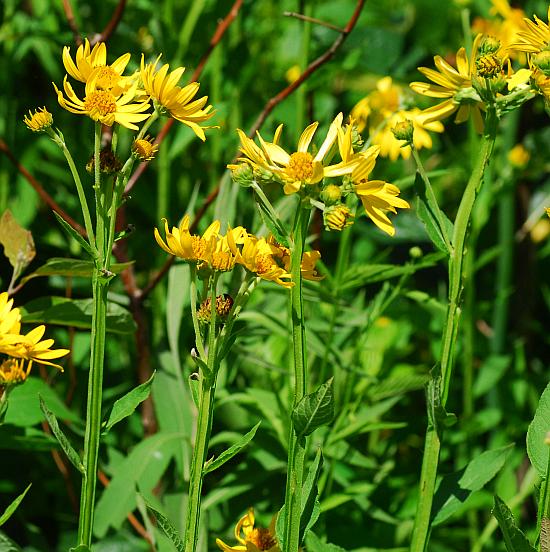Verbesina helianthoides Michx.
Yellow Crownbeard

Native
CC = 5
CW = 5
MOC = 59
© SRTurner
Verbesina helianthoides Michx.Yellow Crownbeard | |
 |
Native CC = 5 CW = 5 MOC = 59 |
© SRTurner |
|
Family - Asteraceae/Heliantheae Habit - Perennial forb with fibrous, sometimes slightly fleshy roots and usually short, more or less stout rhizomes. Stems - Ascending to erect, to 1.2 m, narrowly and sometimes incompletely winged, moderately to densely pubescent with short, fine, loosely ascending hairs.
Leaves - Alternate, the lowermost leaves sometimes opposite, sessile or the lowermost leaves with a short, usually poorly differentiated petiole, the base usually strongly decurrent below the attachment point as a pair of wings. Blades 5-55 cm long, lanceolate to narrowly ovate, tapered at the base, angled or tapered to a sharply pointed tip, the margins usually finely toothed, occasionally nearly entire, the upper surface moderately to densely pubescent with relatively soft, spreading, pustular-based hairs, often slightly roughened to the touch, the undersurface densely pubescent with appressed to somewhat spreading hairs, usually felty to the touch.
Inflorescences - Loose terminal clusters of 2-10 heads, sometimes with only a solitary head.
Heads - Involucre 9-16 mm in diameter, cup-shaped, with 16-21 bracts. Involucral bracts 6-9 mm long, narrowly lanceolate or narrowly oblong-lanceolate to lanceolate, ascending to loosely ascending at flowering, the outer surface moderately to densely hairy. Chaffy bracts narrowly lanceolate to narrowly oblong-oblanceolate, moderately to densely hairy, especially toward the tip.
Florets - Ray florets 8-15, pistillate or sterile, the corolla 10-30 mm long, spreading, yellow. Disc florets 40-80, the corolla 3.5-4.5 mm long, yellow. Pappus of the ray and disc florets usually similar (but that of the ray florets usually somewhat broader, flattened, and scalelike), of 2 slender to relatively stout awns 0.5-1.5 mm long, smooth or with fine, upward-pointed barbs, more or less persistent at fruiting.
Fruits - Achenes, ascending to somewhat spreading at maturity within a hemispherical cluster, 4-5 mm long, the body usually oblanceolate to narrowly obovate, narrowly to broadly winged, occasionally wingless, the surface glabrous or more commonly moderately to densely pubescent with short, stout, pustular-based hairs. Flowering - May - October. Habitat - Rocky or dry open woods, savannas, prairies, roadsides, railroads. Origin - Native to U.S. Lookalikes - Broadly, numerous other members of the family, especially species of Heliopsis, Helianthus, Rudbeckia, and others. Other info. - This attractive species is found across most of Missouri but is less common or absent in far northern and northwestern regions of the state. Its distribution within the continental U.S. is a well-defined patch encompassing several states within the Midwest. It is reasonably easy to identify from its conspicuously winged stems, though this feature is somewhat variable. Other species with winged stems have flowering heads which look significantly different. In V. alternifolia, the central disk is nearly hemispherical in shape, with disk florets pointing in all directions and the ray florets tending to droop. Species of Helenium also have winged stems, but the receptacle of the flowering head in those plants is again conspicuously hemispherical or nearly spherical. V. helianthoides is also a relatively early bloomer. Most other members of the family with large yellow heads bloom later in the year. Photographs taken at Daniel Boone Conservation Area, Warren County, MO, 7-1-2013, Don Robinson State Park, Jefferson County, MO, 5-24-2017, and at Shaw Nature Reserve, Franklin County, MO, 6-13-2019 (SRTurner). |